
Table of Contents
Scientific Classification
- Kingdom: Animalia
- Phylum: Chordata
- Class: Reptilia
- Order: Squamata
- Family: Agamidae
- Genus: Chlamydosaurus
- Species: C. kingii
Quick Overview
The Frilled Lizard (Chlamydosaurus kingii), often referred to as the Frill-necked Lizard, is a unique reptile renowned for the dramatic frill around its neck. Native to Australia and Papua New Guinea, this lizard has fascinated people worldwide with its distinctive defensive posture.
Fast Facts
- Scientific Name: Chlamydosaurus kingii
- Lifespan: Approximately 10-15 years in the wild; can live longer in captivity with proper care.
- Average Size: 2.5-3 feet, including tail.
- Diet: Carnivorous.
- Habitat: Tropical and warm temperate forests, as well as savannah woodlands.
Did you know?
The Frilled Lizard predominantly resides in trees, a behavior that has led to its informal nickname as the “tree-climber.”
Appearance
The Frilled Lizard’s defining characteristic is its prominent frill, which can vary in color and is used as a defense mechanism. When threatened, it displays this frill while opening its mouth, giving it a larger and more intimidating appearance. Their coloration, ranging from vibrant green to grey, often mirrors their environment, providing natural camouflage.
Size and Weight
These lizards typically measure between 2.5 to 3 feet from snout to tail tip. While they’re slender, males generally outweigh females, although both are relatively lightweight.
Temperament and Behavior
Solitary by nature, these reptiles can become territorial, especially males. Their most iconic behavior is the display of their frill when they sense danger, often accompanied by hissing. If on the ground, they might even stand on their hind legs.
Fun Fact:
Threatened Frilled Lizards adopt a bipedal stance, running on their hind legs, which enhances their dramatic defensive posture.
Habitat and Distribution
Endemic to parts of northern Australia and southern Papua New Guinea, they favor humid climates, from tropical savannah woodlands to dense forests. Their arboreal nature means they spend most of their time in trees.
Care Guide
For potential Frilled Lizard enthusiasts:
- Offer a vertically spacious enclosure to cater to their tree-dwelling habits.
- UVB lighting is essential, alongside a controlled temperature gradient.
- Their diet should mainly comprise insects, such as crickets and locusts.
- Humidity levels should be consistently monitored and maintained.
- Regular vet check-ups are crucial for their well-being.
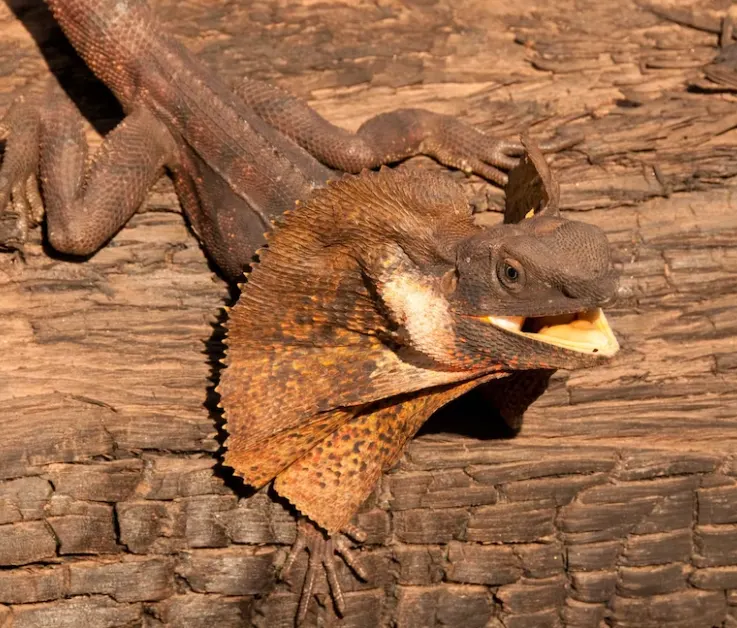
Diet and Nutrition
Frilled Lizards predominantly hunt insects and spiders in the wild. Occasionally, they might consume smaller mammals or reptiles. In captivity, a diverse diet of crickets, mealworms, and suitable prey is recommended.
Health and Wellness
Captive Frilled Lizards are prone to conditions like metabolic bone disease due to improper lighting and diet. They might also suffer respiratory ailments. However, with timely care and regular vet visits, most health concerns can be addressed.
Breeding
Oviparous in nature, female Frilled Lizards lay clutches post-mating, usually containing around 8-23 eggs. These are buried in suitable substrates and incubate for about two to three months, though this can vary based on conditions.
Conservation Status
While not currently classified as endangered, the Frilled Lizard’s habitat is under threat from various factors. Monitoring their population is essential to ensure their continued survival in the wild.
Fun Fact:
The Frilled Lizard has made appearances in several films and TV shows, boosting its global recognition.
Photo Gallery
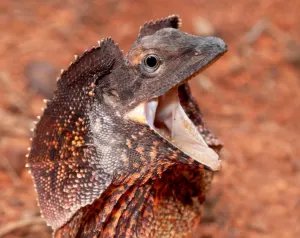
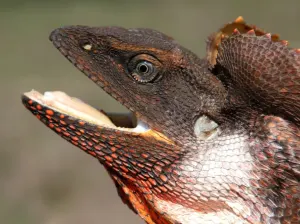
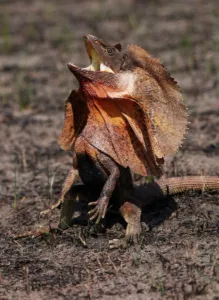
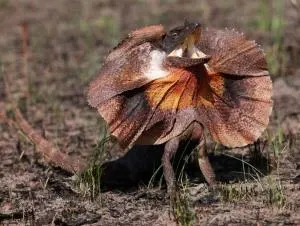
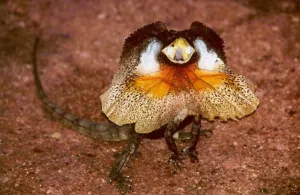
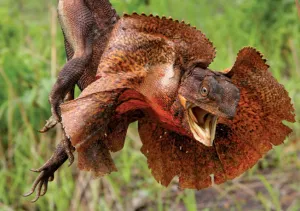
Check out the video below on how a Frill-Necked Lizard escapes a python:
Related Profiles
Share This Profile:
3 Amazing Facts About Frilled Lizard
- Defensive Mastery: The Frilled Lizard’s signature defense involves displaying its vibrant frill and opening its mouth wide, showcasing its bright oral cavity.
- Two-legged Sprinter: Among the few lizards that sprint bipedally, the Frilled Lizard presents an intriguing sight when threatened.
- Arboreal Specialist: With curved claws designed for gripping, the Frilled Lizard navigates tree canopies with ease, keeping it safe from many ground-based threats.
- Enchi Ball Python: A Unique and Stunning Morph of Python regius - March 27, 2025
- Emerald Tree Monitor: The Enigmatic Green Guardian of the Rainforest - March 26, 2025
- The Egyptian Cobra (Naja haje): A Fascinating Serpent - March 25, 2025
